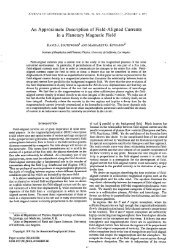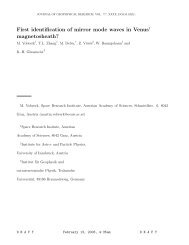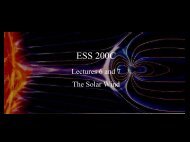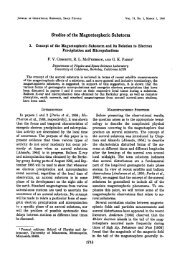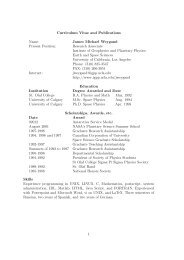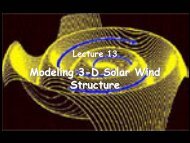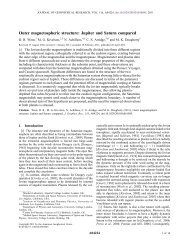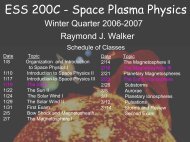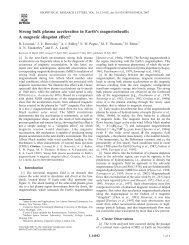Drag and Propulsion of Large Satellites in the Ionosphere: An ...
Drag and Propulsion of Large Satellites in the Ionosphere: An ...
Drag and Propulsion of Large Satellites in the Ionosphere: An ...
- No tags were found...
You also want an ePaper? Increase the reach of your titles
YUMPU automatically turns print PDFs into web optimized ePapers that Google loves.
3OURNAL OF GEOPHYSICAL RESEARCH VOL. 70, NO. ]3 3ULY 1, 1965<strong>Drag</strong> <strong>and</strong> <strong>Propulsion</strong> <strong>of</strong> <strong>Large</strong> <strong>Satellites</strong> <strong>in</strong> <strong>the</strong> <strong>Ionosphere</strong>'<strong>An</strong> Alfv(n <strong>Propulsion</strong> Eng<strong>in</strong>e <strong>in</strong> SpaceS. D. DRELL, 1 H. M. FOLEY, 2 AND M. A. RUDERMAN 3Jason Division, Institute/or De/ense <strong>An</strong>alysesAbstract. There is a motionally <strong>in</strong>duced charge separation <strong>in</strong> a conductor mov<strong>in</strong>g acrossmagnetic field l<strong>in</strong>es. This charge may be conducted away, result<strong>in</strong>g <strong>in</strong> adc current flowthrough <strong>the</strong> conductor if it moves through a plasma. The generation <strong>of</strong> Alfv•n waves is amechanism particularly effective for circulat<strong>in</strong>g <strong>the</strong> charge for very large conductors mov<strong>in</strong>g<strong>in</strong> or above <strong>the</strong> earth's ionosphere. This mechanism is studied <strong>in</strong> this paper <strong>and</strong> when appliedto <strong>the</strong> analysis <strong>of</strong> <strong>the</strong> orbit <strong>of</strong> <strong>the</strong> Echo satellite is found to give rise to a significant damp<strong>in</strong>g<strong>of</strong> <strong>the</strong> motion as mechanical energy is converted to that <strong>of</strong> Alfv•n radiation. The calculateddrag is comparable to that observed for <strong>the</strong> orbit <strong>of</strong> Echo I <strong>and</strong> attributed <strong>in</strong> earlier studiesentirely to <strong>the</strong> mechanical drag <strong>of</strong> considerable nonionized atmospheric density. Perturbations<strong>in</strong> electron density associated with this current flow may <strong>in</strong> appropriate circumstances bedetectable even thous<strong>and</strong>s <strong>of</strong> kilometers away from such a high altitude satellite. The dragcan be changed to a propulsion mechanism when a source <strong>of</strong> electrical power is available on<strong>the</strong> satellite. Up to fifty per cent <strong>of</strong> <strong>the</strong> expended power is available for push<strong>in</strong>g a spacevehicle across an ambient magnetic field.1. INTRODUCTIONA conductor mov<strong>in</strong>g across a magnetic fieldB0 <strong>in</strong> a vacuum will have an <strong>in</strong>duced chargeseparation sufficient to cancel <strong>the</strong> electric fieldE = (v X B0)/c seen by a co-mov<strong>in</strong>g observer.When <strong>the</strong> surround<strong>in</strong>g medium is a plasma, <strong>the</strong>reexist possible mechanisms for charge to be conductedaway, result<strong>in</strong>g <strong>in</strong> adc current flow<strong>in</strong>gthrough <strong>the</strong> conductor. In this paper we consider<strong>the</strong> circulation <strong>of</strong> charge by means <strong>of</strong> <strong>the</strong> generation<strong>of</strong> Alfv•n waves, a mechanism which isparticularly effective for very large conductorsmov<strong>in</strong>g <strong>in</strong> or above <strong>the</strong> earth's ionosphere. Whenapplied to a study <strong>of</strong> <strong>the</strong> Echo satellite it givesrise to a significant damp<strong>in</strong>g <strong>of</strong> <strong>the</strong> orbit asmechanical energy is converted to that <strong>of</strong> Alfv•nradiation. The calculated drag is equal to thatobserved for <strong>the</strong> orbit <strong>of</strong> Echo 1 <strong>and</strong> attributed<strong>in</strong> earlier studies entirely to <strong>the</strong> mechanical drag<strong>of</strong> considerable nonionized atmospheric density.In an appropriately designed satellite <strong>the</strong> dragforce can be altered by variations <strong>of</strong> an <strong>in</strong>ternalresistance, or <strong>the</strong> associated dc current flow canx Stanford L<strong>in</strong>ear Accelerator Center, StanfordUniversity, Stanford, California.2 Physics Department, Columbia University,New York, New York.a Physics Department, New York University,New York, New York.3131be tapped as a battery. With a source <strong>of</strong> electricalpower <strong>the</strong> drag force can be converted to apropulsion mechanism: <strong>the</strong> satellite pushes on<strong>the</strong> earth's magnetic field without any emission<strong>of</strong> propellant.We exploit <strong>the</strong> qualitative analogy between acollisionless plasma <strong>in</strong> a magnetic field <strong>and</strong> aseries <strong>of</strong> transmission l<strong>in</strong>es parallel to <strong>the</strong> magneticfield. The mov<strong>in</strong>g conductor with itsmotionally <strong>in</strong>duced charge separation is, <strong>in</strong> asense, <strong>in</strong> successive contact with different transmissionl<strong>in</strong>es as it moves. It <strong>in</strong>duces an impulse(Alfv•n wave) travel<strong>in</strong>g along <strong>the</strong> magnetic fieldwhich carries a charge separation <strong>and</strong> essentiallycompletes <strong>the</strong> circuit <strong>in</strong> which <strong>the</strong> mov<strong>in</strong>gconductor is adc battery.Initially we shall idealize <strong>the</strong> conductor sothat it not only has no <strong>in</strong>ternal resistance butalso no work function to prevent <strong>the</strong> outwardflow <strong>of</strong> electrons <strong>in</strong> response to an appropriatelydirected electric field normal to its surface. Theproposed mechanism is appropriately modifiedfor real conductors for which <strong>the</strong> work functionis significant.Alfv•n waves, magnetohydrodynamic disturbances<strong>of</strong> frequency much less than <strong>the</strong> ioncyclotron frequency 9i = eBo/Mic, propagateone-dimensionally along <strong>the</strong> direction B0. Asmall disturbance persists with constant amplitudeor until damped by collisions among elec-
3132 DRELL, FOLEY, AND RUDERMANFig. 1. Conductor mov<strong>in</strong>g with velocity vc <strong>in</strong> <strong>the</strong> x direction perpendicular to magnetic fieldl<strong>in</strong>es Bo along <strong>the</strong> z direction lead<strong>in</strong>g to a charge separation <strong>and</strong> mottonal electric field E <strong>in</strong><strong>the</strong> y direction.trons <strong>and</strong> ions <strong>in</strong> <strong>the</strong> plasma. We have notfound <strong>the</strong> solution <strong>of</strong>fered here <strong>in</strong> earlier studies<strong>of</strong> related problems; <strong>the</strong>se have been twodimensional,or <strong>in</strong>volved only motion parallelto B0, or posed boundary conditions that <strong>the</strong>plasma was not disturbed at large distancesfrom <strong>the</strong> conductor, none <strong>of</strong> which are valid forour solution. Moreover, we f<strong>in</strong>d <strong>in</strong> <strong>the</strong> restframe <strong>of</strong> <strong>the</strong> mov<strong>in</strong>g conductor a steady dccurrent ra<strong>the</strong>r than a static situation.2. IDEAL CONDUCTOR IN A LOSSLESS PLASMAFor <strong>the</strong> idealized conductor (see section 1)mov<strong>in</strong>g through a collisionless plasma <strong>in</strong> adirection perpendicular to <strong>the</strong> field l<strong>in</strong>es (Figure1), <strong>the</strong> Alfv•n disturbance extends out <strong>in</strong> w<strong>in</strong>gsmak<strong>in</strong>g an angle a with <strong>the</strong> field l<strong>in</strong>es such thattanwhere v• = speed <strong>of</strong> <strong>the</strong> conductor, <strong>and</strong> Va ------Alfv•n speed. The motional electric fieldr =x<strong>in</strong> <strong>the</strong> conductor is cancelled by a charge separationas illustrated <strong>in</strong> Figure 1. In <strong>the</strong> collisionlessplasma, with <strong>in</strong>f<strong>in</strong>ite conductivity along <strong>the</strong> B0,or z, direction, but with zero conductivity perpendicularto B0, current w<strong>in</strong>gs as shown <strong>in</strong>Figure 2 are created along with a charge separationas required to ma<strong>in</strong>ta<strong>in</strong> a constant • fieldalong <strong>the</strong> w<strong>in</strong>g equal to that at <strong>the</strong> conductor.<strong>An</strong>omalous radar echoes obta<strong>in</strong>ed from ionosphericdisturbances associated with Echo I mayalso be related to <strong>the</strong>se predicted Alfv•n 'w<strong>in</strong>gs,'although fur<strong>the</strong>r studies are desirable to confirm<strong>the</strong>ir presence. We comment more on this <strong>in</strong>section 5.Let us first analyze <strong>the</strong> fields produced by <strong>the</strong>motion <strong>of</strong> an ideal conductor through a plasmawith an impressed magnetic field B0 <strong>in</strong> order toestablish <strong>the</strong> appropriate regime <strong>of</strong> parameters<strong>and</strong> <strong>the</strong> nature <strong>of</strong> <strong>the</strong> Alfv•n disturbance. Wemake <strong>the</strong> follow<strong>in</strong>g approximations:1. The conductor mov<strong>in</strong>g through <strong>the</strong> plasmais 'ideal'--i.e., it has zero <strong>in</strong>ternal resistance<strong>and</strong> work function; it ma<strong>in</strong>ta<strong>in</strong>s <strong>the</strong> chargeseparation required to produce <strong>the</strong> fieldr = --(vc X B0)/½ (1)In <strong>the</strong> opposite case <strong>of</strong> a conductor with <strong>in</strong>ternalresistance mov<strong>in</strong>g through a medium <strong>of</strong> higherconductivity, <strong>the</strong> charges would be 'bled' fromTopBottomt 4 - z + + ++---m,..YlFig. 2. Alfv•n w<strong>in</strong>gs generated by an ideal conductor<strong>in</strong> a collisionless plasma.vc
3134DRELL, FOLEY, AND RUDERMANiooo900800700E',' 600i /Day sunspot maximum i • ,!--.--Night sunspot maximum-----Night .... Daysunspotm<strong>in</strong>imumßß • 5004OO•002OO.•..•.•;.•'•ßII:, ii•.'•'1Fig. 4.I0010 -15 I 0-12 10- II I 0-10 I 0 -9 I 0-8Specific electrical conductivity %, abmho/cmSpecific electrical conductivity <strong>of</strong> <strong>the</strong> ionosphere (zero field conductivity) versusaltitude; taken from Johnson [1961].where4•rn M ;c 2Bo 2I + 4•rpic2 -- I + c•'/va(8)•--Bo 2(•oV•.,,),• -•def<strong>in</strong>es <strong>the</strong> Alfv•n velocity <strong>in</strong> terms <strong>of</strong> <strong>the</strong> magneticfield strength B0 <strong>and</strong> <strong>the</strong> ionic massdensity pi ---- nMi. Numerically <strong>the</strong> plasma frequencyvaries from c% • 6 X 107 cps at altitudes<strong>of</strong> a few hundred km correspond<strong>in</strong>gto electron densities <strong>of</strong> up to 106/cm 3, tow• • 4 X 106 cps at altitudes <strong>of</strong> 1600 km <strong>and</strong>electron densities <strong>of</strong> .--5 X 103/cm s. The Alfv•nvelocities rise from values <strong>of</strong> va • 2 X 107cm/sec at 300-k<strong>in</strong> altitude to v• • 10 • cm/secat 1600-km altitude. The value at 1600 km isnot accurately known, ow<strong>in</strong>g to uncerta<strong>in</strong>ties <strong>in</strong><strong>the</strong> ionic composition at <strong>the</strong> high altitudes. Wereturn to this po<strong>in</strong>t later. The ratio <strong>of</strong> parallelto transverse components <strong>of</strong> e is very large for<strong>the</strong> parameters <strong>of</strong> <strong>in</strong>terest to us,[e,,/•_[ > 10 • (9)Essentially <strong>the</strong> electrons are wrapped around<strong>the</strong> magnetic field l<strong>in</strong>es, free to move only along<strong>the</strong> Bo direction, as are <strong>the</strong> ions. This large ratioreflects propagation only <strong>in</strong> <strong>the</strong> direction parallelto B0.We want now to solve <strong>the</strong> Maxwell equationsV x r = -V X B = i)/c d- 4•-j,/c (10)V.D = 4•rp.V.B=0with D <strong>and</strong> E related by (5) <strong>and</strong> (6) <strong>and</strong> withj. <strong>and</strong> p, represent<strong>in</strong>g <strong>the</strong> current <strong>and</strong> chargesource provided by <strong>the</strong> mov<strong>in</strong>g conductor. Thecurrent <strong>in</strong> <strong>the</strong> mov<strong>in</strong>g conductor <strong>of</strong> Figure 1flows ma<strong>in</strong>ly <strong>in</strong> <strong>the</strong> y direction to ma<strong>in</strong>ta<strong>in</strong> <strong>the</strong>charge separation. We work <strong>in</strong> a l<strong>in</strong>earizedapproximation <strong>in</strong> <strong>the</strong> field strengths E <strong>and</strong>h = B-- B0;f• = 1].Fourier transform<strong>in</strong>g (10) we havek x •(•., •,,,o) = o•_h (•_,•,,,o)(•)k X h = •oD 4•ri j,(k_L, k,,)•(•0 -- k.vc)cceilkllEll Ji- ezkz' E• = 4•rp.(lib)(11c)Tak<strong>in</strong>g <strong>the</strong> curl <strong>of</strong> (11a), <strong>in</strong>sert<strong>in</strong>g (lib) <strong>and</strong>(11c), <strong>and</strong> def<strong>in</strong><strong>in</strong>g Ez = Ez • -t- Ez", where
DRAG AND PROPULSION IN THE IONOSPHERE 3135k. ß E• • k.E. • <strong>and</strong> kx X E• • k. X E•' r, givesez k, -- kz 2 Eza medium at speeds greater than <strong>the</strong> lightvelocity <strong>in</strong> <strong>the</strong> medium.In this lossless plasma approximation, <strong>the</strong>equations for E <strong>and</strong> h read4srkip.•-- k.k2)E.k t"(12a)4•-i= • ',o•e -- •','c) I• X •_•/a (•,)½• ell - k•_ -- kll eñ] "-0 (12c)n. = •(• x r)•/(•.•c) (•)hi' = c(ki (k' X v•) Ex 'r)General features <strong>of</strong> <strong>the</strong> solution can be identi-(12e)fied <strong>in</strong> (12). For a plasma with low transverseconductivity which approaches <strong>the</strong> behavior <strong>of</strong>a lossless medium satisfy<strong>in</strong>g (9), (12a) reducesto a one-dimensional wave equation for atransverse electric field propagat<strong>in</strong>g along <strong>the</strong>B0 direction with velocity c/eJ/'. •' Va accord<strong>in</strong>gto (8) <strong>and</strong> with frequency<strong>and</strong> longitud<strong>in</strong>al wavelengtho• -- k'vc (13)xll-- •1-•1=va• - k.v•Va (14)4•r 0c 2 OtVñ'js(x -- Vct, y, z) (15a)at 0 • v•)(V• x r•)4;r 0c 20t•_ x •(:• - ,,ct, y, •) (1,•,)fi• = -c(V x r)•fi, -- --c(Vx X rx)(•)(15d)with Ell = 0. Equation 15b describes <strong>the</strong> netradiation <strong>of</strong> energy <strong>in</strong>to a magnetoionic wavewith velocity va only if vc > va. As we noted,this radiation is analogous to <strong>the</strong> Ccrenkovradiation, or sonic boom. Equation 15a radiatesenergy out along <strong>the</strong> direction <strong>of</strong> B0 for allvalues <strong>of</strong> vc if <strong>the</strong> idealized conductor movesacross <strong>the</strong> magnetic field l<strong>in</strong>es <strong>and</strong> plucks <strong>the</strong>mlike viol<strong>in</strong> str<strong>in</strong>gs. This solution satisfies <strong>the</strong>equationBo.(Vx X r•) = 0 (16)so that a two-dimensional slice perpendicular toB0 gives <strong>the</strong> electric field from a two-dimensionalcharge distribution (Vx' Ex). Accord<strong>in</strong>g to (15a),<strong>the</strong> Alfv•n fields are functions only <strong>of</strong> <strong>the</strong>variablesThis is <strong>the</strong> Alfv•n wave. Accord<strong>in</strong>g to (13), for <strong>the</strong>dom<strong>in</strong>ant transverse wave numbers k. •' l/L,Vawhere L is <strong>the</strong> dimension <strong>of</strong> <strong>the</strong> current source<strong>and</strong> propagate as described earlier <strong>in</strong> Figuresalong <strong>the</strong> direction <strong>of</strong> motion, <strong>the</strong> frequency is 1 <strong>and</strong> 2. The w<strong>in</strong>gs move out from <strong>the</strong> conductorco •, vc/L, as was claimed earlier <strong>in</strong> (3). There is, with Va along B0 <strong>and</strong> form an angle a such that<strong>in</strong> addition, accord<strong>in</strong>g to (12b) an isotropicdistu-'rbance which is a solution <strong>of</strong> <strong>the</strong> ord<strong>in</strong>aryd'Alcmbcrtian wave equation, also with Alfv•n as illustratedtan a =<strong>the</strong>re.velocity va. For a steady source current generatedFor <strong>the</strong> magnitudes <strong>of</strong> <strong>the</strong> fields, we knowby a mov<strong>in</strong>g conductor with v• < va, <strong>the</strong> solutionfrom <strong>the</strong> first <strong>of</strong> (10) that <strong>the</strong> tangential comisa localized disturbance fall<strong>in</strong>g <strong>of</strong>f as 1/r'. atponent <strong>of</strong> • is cont<strong>in</strong>uous across <strong>the</strong> conductorlarge distances from <strong>the</strong> source; this is <strong>the</strong> casesurface <strong>and</strong> is fixed by <strong>the</strong> motional electricapply<strong>in</strong>g here. When, however, v• > va, a radiafield<strong>in</strong> <strong>the</strong> conductor accord<strong>in</strong>g to (1):tion pattern is created that is <strong>the</strong> analog <strong>of</strong> <strong>the</strong>Cerenkov radiation for a charge pass<strong>in</strong>g throughE = --(v• X Bo)/C (17)
3136 DRELL, FOLEY, AND RUDERMAN¾i/M--'v', vFig. 5.<strong>An</strong>/-bar conductor idealized as two fiat rectangular plates with <strong>in</strong>dicated dimensionscharged to ma<strong>in</strong>ta<strong>in</strong> <strong>the</strong> potential difference V.S<strong>in</strong>ce we are deal<strong>in</strong>g with long wavelength modes<strong>of</strong> field excitation <strong>and</strong> by (14)1/kll >> 1/k•_ • L<strong>the</strong> detailed three-dimensional geometric shape<strong>of</strong> <strong>the</strong> mov<strong>in</strong>g conductor is <strong>of</strong> no relevance. Wecan write an exact solution for an /-bar con-ductor described as <strong>in</strong> Figure 5 by two fiatrectangular plates <strong>of</strong> dimensions L <strong>and</strong> N,separated by a distance M, <strong>and</strong> charged toma<strong>in</strong>ta<strong>in</strong> a potential difference <strong>in</strong> <strong>the</strong> y direction<strong>of</strong>v = =The solution consists <strong>of</strong> grow<strong>in</strong>g parallel w<strong>in</strong>gswith a charge sufficient to keep <strong>the</strong> difference <strong>in</strong>potential between <strong>the</strong> w<strong>in</strong>gs always V. Thecurless part <strong>of</strong> Ex, which is <strong>the</strong> solution <strong>of</strong> (15a),has <strong>the</strong> functional form_,ct_,_ z ,<strong>and</strong> is <strong>the</strong> solution <strong>of</strong> <strong>the</strong> two-dimensiOnal problemcorrespond<strong>in</strong>g to Figure 5, i.e. two plates<strong>of</strong> width L <strong>and</strong> separation M mak<strong>in</strong>g an anglea = tan -• (Vc/V,,) with B0. A constant potentialdifference V is ma<strong>in</strong>ta<strong>in</strong>ed between <strong>the</strong> w<strong>in</strong>gs,so that Ell -- 0, <strong>and</strong> a constant current j8 flowsthrough <strong>the</strong> I bar <strong>in</strong> <strong>the</strong> y direction. Only outalong <strong>the</strong> horizontal arms <strong>of</strong> <strong>the</strong> I bar <strong>in</strong> <strong>the</strong> xdirection does <strong>the</strong> current j8 decrease (i.e.,•'x'jx.• • 0) as current flows <strong>in</strong>to <strong>the</strong> w<strong>in</strong>gs.The vertical current <strong>in</strong> <strong>the</strong> source must beexactly sufficient to supply <strong>the</strong> charge neededfor <strong>the</strong> two grow<strong>in</strong>g w<strong>in</strong>gs tips, i.e.E •_ Lc 2v cc LI., --'• - Bo2•'v • 2,rv •We note that <strong>the</strong> field Ex that moves down<strong>the</strong> tube <strong>in</strong> <strong>the</strong> B0 direction is not particularlydifferent if <strong>the</strong> mov<strong>in</strong>g source is <strong>the</strong> I bar or asolid plate <strong>of</strong> <strong>the</strong> same dimensions. Only <strong>the</strong>fr<strong>in</strong>g<strong>in</strong>g fields near <strong>the</strong> vertical edges are different,as is <strong>in</strong>dicated <strong>in</strong> Figure 6. In particular <strong>the</strong>power radiated <strong>in</strong>to <strong>the</strong> Alfv•n-type waves isessentially <strong>the</strong> same <strong>in</strong> both cases; <strong>the</strong> effectiveradiat<strong>in</strong>g area need not be filled with conductor.For <strong>the</strong> magnetic field, (15c) <strong>and</strong> (17) give= (between <strong>the</strong> plates plus correction terms near<strong>the</strong> edges from <strong>the</strong> fr<strong>in</strong>g<strong>in</strong>g fields plus correctionsvanish<strong>in</strong>g as one moves out <strong>in</strong>to <strong>the</strong> radiationzone far from <strong>the</strong> body due to local currents.A small ratio <strong>of</strong> <strong>the</strong> Alfv•n field [hi to <strong>the</strong> earth'sfield B0 is a necessary criterion for <strong>the</strong> l<strong>in</strong>earapproximation we have made. For satellites <strong>in</strong>earth orbit, we have• 4 X 10 -2 at 200-km altitude10 -a at 1600-km altitudealways very small next to unity.The sufficiency condition for <strong>the</strong> validity <strong>of</strong><strong>the</strong> neglect <strong>of</strong> higher-order terms depends on <strong>the</strong><strong>in</strong>terval over which we need to be sure <strong>of</strong> anaccurate solution. For computations <strong>of</strong> <strong>the</strong>current flow through <strong>the</strong> mov<strong>in</strong>g satellite, itsdrag, <strong>and</strong> <strong>the</strong> power radiated <strong>in</strong>to <strong>the</strong> Alfv•nwaves, <strong>the</strong> solution should be valid out to adistance <strong>of</strong> about 1 wavclcngth/2•r --• Va/00away from <strong>the</strong> conductor. Over this <strong>in</strong>terval hxmay cause a change <strong>in</strong> direction for <strong>the</strong> flow <strong>of</strong>charge away from <strong>the</strong> z axis by an angle •'•h_t./Bo<strong>and</strong> a resultant transverse displacement <strong>of</strong>(hzv•)/(Bow). For this not to exceed <strong>the</strong> transversedimension <strong>of</strong> <strong>the</strong> Alfv•n wave, we needh•_v, • Bow/kx =Bov,
DRAG AND PROPULSION IN THE IONOSPHERE 3137Fig. 6. Fr<strong>in</strong>g<strong>in</strong>g fields differ<strong>in</strong>g for I bar or solid plate conductors.orstant z) <strong>of</strong> <strong>the</strong> Alfv•n tube (w<strong>in</strong>g) moves as ifhj_/B 0 • •)c/•a (20)through an <strong>in</strong>compressible fluid. In <strong>the</strong> comov<strong>in</strong>gframe <strong>the</strong> electric field vc X Bo/COnly for an ideal conductor with no <strong>in</strong>ternalresistance mov<strong>in</strong>g <strong>in</strong> a collisionless plasma <strong>in</strong>toge<strong>the</strong>r with that <strong>of</strong> an <strong>in</strong>f<strong>in</strong>itesimally th<strong>in</strong>charge distribution looks like that <strong>in</strong> Figure 7.which <strong>the</strong> <strong>in</strong>ertia <strong>of</strong> <strong>the</strong> electrons is negligible The drift velocity v <strong>of</strong> ions <strong>in</strong> <strong>the</strong> crossed electriccan <strong>the</strong> left-h<strong>and</strong> side <strong>of</strong> (20) ga<strong>in</strong> even equality <strong>and</strong> magnetic fields iswith <strong>the</strong> right-h<strong>and</strong> side.For an irregularly shaped three-dimensionalideal conductor for which v•/va
3138 DRELL, FOLEY, AND RUDERMANP = (1/47r)h22(ML)va (21)- Bø2 vc• (ML)2•rwhere 2MLv• is <strong>the</strong> volume filled per second byan energy density h2/4•r; <strong>the</strong> factor 2 takes <strong>in</strong>toaccount <strong>the</strong> existence <strong>of</strong> w<strong>in</strong>gs extend<strong>in</strong>g <strong>in</strong> bothdirections along B0. Comb<strong>in</strong><strong>in</strong>g with (18) for <strong>the</strong>potential difference between <strong>the</strong> top <strong>and</strong> bottomw<strong>in</strong>g, we compute <strong>the</strong> current flow:The effective impedance <strong>of</strong> <strong>the</strong> plasma for thiscurrent flow is <strong>the</strong>n def<strong>in</strong>ed asVz - -In terms <strong>of</strong> <strong>the</strong>se familiar quantities <strong>of</strong> electricalcircuit <strong>the</strong>ory, <strong>the</strong> Alfv•n w<strong>in</strong>gs can be <strong>in</strong>terpretedas one-dimensional open-ended transmissionl<strong>in</strong>es <strong>of</strong> impedance Z across which apotential V is applied. In this ideal limit <strong>of</strong> alossless medium, <strong>the</strong>re is an <strong>in</strong>f<strong>in</strong>ite resistancebetween <strong>the</strong> upper <strong>and</strong> lower l<strong>in</strong>e (or Alfv6nw<strong>in</strong>g) <strong>and</strong> zero resistance along <strong>the</strong>m. Correctionsdue to collisions lead<strong>in</strong>g to a f<strong>in</strong>ite transverseionic conductivity are computed <strong>in</strong> <strong>the</strong> nextsection.The l•rge electronic surface charge density•rises from <strong>the</strong> enormous dielectric constantsex • 1 + c:/vd (•th v•lues between 10a •nd10•). The totM charge density given by div. E issmaller by (v•/c):; i.e., •lmost •11 <strong>the</strong> electroniccharge density is c•ncelled by <strong>the</strong> ions. Thisl•rge pol•fiz•bility <strong>of</strong> <strong>the</strong> heavy pl•sm• ions•11 always result <strong>in</strong> •n ionic displacement muchsmaller th•n <strong>the</strong> w<strong>in</strong>g separation •s long as <strong>the</strong>verficM dimension <strong>of</strong> <strong>the</strong> body, M, satisfiesv•/M
DRAG AND PROPULSION IN THE IONOSPHERE3139for •0 < 103 cps <strong>and</strong> for 1/k•, • M > 10 meters.This means that <strong>the</strong> w<strong>in</strong>gs cannot be consideredto have zero thickness, but will spreadto a thickness <strong>of</strong> perhaps ten meters. Theimag<strong>in</strong>ary (damp<strong>in</strong>g) correction from electroncollisions is also small for <strong>the</strong>se conditions when1/kj. •> 10 meters accord<strong>in</strong>g to Figure 3.For higher altitude orbits above 1000 km, <strong>the</strong>damp<strong>in</strong>g term i/oor• <strong>in</strong> (28) is < 1 <strong>in</strong> magnitudefor •0 •> 10 eps, correspond<strong>in</strong>g to conductordimensions no larger than L • 1000 meters (for<strong>the</strong> Echo 1 with L • 30 meters at an altitude <strong>of</strong>1600 km, <strong>the</strong> correction is less than a few percent). The real factor <strong>in</strong> (28), however, leads toa major change <strong>in</strong> <strong>the</strong> radiated Alfv•n waveunless 1/ki •> 75 meters; <strong>the</strong> simple Alfv•nsolution propagat<strong>in</strong>g <strong>in</strong> one dimension onlyapplies only to <strong>the</strong> modes with ki •< 1/75 meters<strong>and</strong> with frequency •0 •> 10 eps, <strong>and</strong> we restrictour attention to <strong>the</strong>se. Thus <strong>the</strong> w<strong>in</strong>g thicknessfor <strong>the</strong>se parameters will, if geometrically possible,spread to more than 75 meters <strong>in</strong> order tocarry <strong>the</strong> required currents, despite <strong>the</strong> electron<strong>in</strong>ertia <strong>and</strong> <strong>the</strong> reduced density <strong>of</strong> electronsabove 1000 km.For an object such as Echo 1 with effectivedimensions <strong>of</strong> L • M • 30 meters for <strong>the</strong>current source as def<strong>in</strong>ed <strong>in</strong> Figure 5, this meansa reduction <strong>in</strong> <strong>the</strong> field strength, s<strong>in</strong>ce only <strong>the</strong>modes with kx < 1/75 meters • L-•/2.5 canbe described by <strong>the</strong> Alfv•n solution discussedhere. S<strong>in</strong>ce <strong>the</strong> power spectrum is flat <strong>in</strong> <strong>the</strong>Z = Z 1 + IZ12+ 2ZlZ 2•- 2Z 1 + Z 2 for Zl/Z 2 > 1.The f<strong>in</strong>ite transverse ionic conductivity between<strong>the</strong> top <strong>and</strong> bottom layers <strong>of</strong> <strong>the</strong> Alfv•n w<strong>in</strong>gs<strong>in</strong> Figures i <strong>and</strong> 2 allows <strong>the</strong> damp<strong>in</strong>g <strong>and</strong>term<strong>in</strong>ation <strong>of</strong> <strong>the</strong> disturbance. View<strong>in</strong>g <strong>the</strong>sew<strong>in</strong>gs as a simple transmission l<strong>in</strong>e, <strong>the</strong>se termsare, respectively, <strong>the</strong> resistance cc (ax•)-• <strong>and</strong><strong>the</strong> capacitance cc (k_•o'_•5/O'o) -• between <strong>the</strong>l<strong>in</strong>es, i.e. <strong>the</strong> impedance Z•. <strong>in</strong> Figure 8 <strong>in</strong> additionto <strong>the</strong> <strong>in</strong>ductance Z• o: Va/C • along <strong>the</strong> l<strong>in</strong>ethrough which <strong>the</strong> current flows.Even if <strong>the</strong> mov<strong>in</strong>g conductor has dimensionssuch that <strong>in</strong>ertial term <strong>of</strong> (27) is smaller than 1,<strong>the</strong> fact that it is nonzero means that <strong>in</strong> <strong>the</strong>dispersion law+ (28')<strong>the</strong> second term on <strong>the</strong> right-h<strong>and</strong> side plays arole at large z: <strong>the</strong> Alfv•n pattern spreads <strong>in</strong> <strong>the</strong>xy plane as it propagates <strong>in</strong> <strong>the</strong> z direction.For subsequent calculations <strong>of</strong> currents <strong>and</strong> dragthrough <strong>the</strong> conductor, it is sufficient that<strong>the</strong> proposed solution be adequate out totransverse wave number kx = (k•, k•.) out toHi/L, <strong>the</strong> power radiated <strong>in</strong> <strong>the</strong> Alfv•n disturbancemust be reduced by a factor • (30/75)•'•z •-• v•/oo • (v•/v•) L. (In <strong>the</strong> transmission l<strong>in</strong>e1/6 from <strong>the</strong> value computed <strong>in</strong> (21).analogy, <strong>the</strong> mov<strong>in</strong>g conductor rema<strong>in</strong>s <strong>in</strong>We have presented <strong>the</strong>se numbers <strong>in</strong> somecontact with a given transmission l<strong>in</strong>e for adetail <strong>in</strong> order to make clear <strong>the</strong> very approxi- time L/v, dur<strong>in</strong>g which <strong>the</strong> signal has traveledmate <strong>and</strong> qualitative nature <strong>of</strong> our numerical a distance v• L/v• <strong>in</strong> <strong>the</strong> z direction. What hapresults<strong>and</strong> to show <strong>the</strong>ir sensitivity to <strong>the</strong> pens after that does not affect <strong>the</strong> forces <strong>and</strong>various atmospheric parameters, variable <strong>in</strong> currents <strong>in</strong> <strong>the</strong> conductor.) From (28') <strong>the</strong>time <strong>and</strong> imperfectly known, that have been used. perpendicular spread<strong>in</strong>g <strong>of</strong> E. is such that forA useful analogy that may help provide a • = •k•physic91 picture <strong>of</strong> this behavior is suggested <strong>in</strong><strong>the</strong> low frequency limit such that •0r• --* 0 <strong>and</strong>c IZOO• v•jz •< 1wr, --* O. Then (28) can be rewritten asTherefore <strong>the</strong> Alfv•n wave spreads ultimately(M2 ito a lateral dimension d which <strong>in</strong>creases as z TM.= -•----•-ax -- ki 2 (29)t/a ½ 0' 0 For ki ,• lfd, v• • 10 • cmfsec, v, • 10 • cm/sec,<strong>and</strong> •%•' --• 10 •3 sec -•., correspond<strong>in</strong>g to n, •5 ) 10•/Sz •/• cm (30)
3140 DRELL, FOLEY, AND RUDERMANAt a distance <strong>of</strong> z ,-• l0 s km, d •> 200 meters,which is an <strong>in</strong>crease <strong>in</strong> size <strong>of</strong> less than a factor<strong>of</strong> 10 for a conductorsuch as Echo 1 <strong>of</strong> size•,30 meters. By conservation <strong>of</strong> energy, <strong>the</strong>reis a correspond<strong>in</strong>g reduction by a factor •10<strong>in</strong> <strong>the</strong> field strengths E x <strong>and</strong> hx <strong>of</strong> <strong>the</strong> Alfv6nwave at <strong>the</strong>se distances. This result suggeststhat, for very high altitude satellites wherecollisions are not dom<strong>in</strong>at<strong>in</strong>g, <strong>the</strong> w<strong>in</strong>gs may bedetectable out to very great distances. Fur<strong>the</strong>r,as <strong>the</strong> Alfv6n wave penetrates to lower altitudeswhere <strong>the</strong> ion density <strong>in</strong>creases <strong>and</strong> Va decreases,energy conservation implies that <strong>in</strong> <strong>the</strong> WKBapproximation D•_E•_Va rema<strong>in</strong>s approximatelyconstant. Therefore <strong>the</strong> charge separation associatedwith <strong>the</strong> wave <strong>in</strong>creases as (Va) -•"'. In thisestimate we have neglected <strong>the</strong> possible growth<strong>of</strong> <strong>the</strong> transverse dimension <strong>of</strong> <strong>the</strong> Alfv6n wavebecause <strong>of</strong> <strong>the</strong> neglect <strong>of</strong> higher-order terms <strong>in</strong>(•).Effect o/ f<strong>in</strong>ite work/unction limit<strong>in</strong>g <strong>the</strong> currentflow through <strong>the</strong> sur/ace o/ a conductor. In <strong>the</strong>upper w<strong>in</strong>g <strong>of</strong> <strong>the</strong> Alfv•n disturbance <strong>in</strong> Figure 2,a negative current flows out from <strong>the</strong> conductor,while <strong>in</strong> <strong>the</strong> lower w<strong>in</strong>g <strong>the</strong> negative flow istoward <strong>the</strong> conductor. In our solution we assumethis flow is ma<strong>in</strong>ta<strong>in</strong>ed <strong>in</strong>def<strong>in</strong>itely withoutchange <strong>in</strong> charge density. The plasma electronsare drawn <strong>in</strong>to <strong>the</strong> conductor surface, neutraliz<strong>in</strong>g<strong>the</strong> electric field <strong>of</strong> <strong>the</strong> ions. In order toma<strong>in</strong>ta<strong>in</strong> <strong>the</strong> charge separation produc<strong>in</strong>g <strong>the</strong>electric field E = --(v•/c) B o, <strong>the</strong> electrons at<strong>the</strong> top surface <strong>of</strong> <strong>the</strong> conductor must be emitted<strong>in</strong>to <strong>the</strong> w<strong>in</strong>gs <strong>and</strong> a current must exist through<strong>the</strong> electrically neutral conductor <strong>in</strong> <strong>the</strong> steadystate. The problem is that <strong>of</strong> overcom<strong>in</strong>g <strong>the</strong>work function at <strong>the</strong> conductor surface so that<strong>the</strong> electron current can flow. The alternativeto this is for <strong>the</strong> current to be carried by <strong>the</strong>ions <strong>in</strong>to <strong>the</strong> surface <strong>of</strong> <strong>the</strong> conductor at <strong>the</strong> top,<strong>and</strong> <strong>the</strong> correspond<strong>in</strong>g reduction <strong>of</strong> <strong>the</strong> con-ductivity •0 by <strong>the</strong> mass ratio m/M; •< 5 X 10 -4would mean <strong>the</strong> failure <strong>of</strong> our simple Alfv•nsolution for <strong>the</strong> scale <strong>of</strong> sizes that we haveconsidered <strong>and</strong> <strong>the</strong> dom<strong>in</strong>ance <strong>of</strong> <strong>the</strong> resistive<strong>and</strong> capacitive corrections discussed <strong>in</strong> <strong>the</strong>preced<strong>in</strong>g section.The proposed solution is valid only if <strong>the</strong>current can be ma<strong>in</strong>ta<strong>in</strong>ed by electrons. S<strong>in</strong>cecold emission is totally negligible, we turn to<strong>the</strong> sun's radiation <strong>and</strong> calculate <strong>the</strong> possibleelectron current which could be ma<strong>in</strong>ta<strong>in</strong>ed byconsider<strong>in</strong>g <strong>the</strong> Alfv•n wave emission toge<strong>the</strong>rwith <strong>the</strong> photoelectric emission dur<strong>in</strong>g <strong>the</strong> daylighthours only. The flux <strong>of</strong> photons from <strong>the</strong>sun deposits 0.140 watt/cm •' as <strong>the</strong> total irra-diance above <strong>the</strong> atmosphere at <strong>the</strong> earth's me<strong>and</strong>istance from <strong>the</strong> sun. This corresponds to <strong>the</strong>total radiation [Johnson, 1961] from a blackbodyat a temperature <strong>of</strong> 5800øK (although <strong>the</strong>spectrum is close to that <strong>of</strong> a blackbody at6000øK). The numbers <strong>of</strong> <strong>in</strong>cident photons percm •' with energies above 2, 3, <strong>and</strong> 4 electronvolts are 1.2 X 10 •7, 3 X 10 •6, <strong>and</strong> 3.5 X 10 •5,respectively. The correspond<strong>in</strong>g maximum photoelectriccurrents for <strong>the</strong>se work functions are20•, 5•, <strong>and</strong> 0.6• milliampere/cm% respectively,where • is <strong>the</strong> efficiency def<strong>in</strong>ed as <strong>the</strong> number<strong>of</strong> electrons emitted per <strong>in</strong>cident photon.For <strong>the</strong> physical parameters <strong>of</strong> <strong>in</strong>terest here<strong>and</strong> with readily achieved efficiencies •, <strong>the</strong>sephotoelectric currents are large enough to ma<strong>in</strong>ta<strong>in</strong><strong>the</strong> Alfv•n disturbance <strong>and</strong> are nowherenear <strong>the</strong> space charge limit <strong>of</strong> Child's Law[Hamwell, 1949]. If we consider Echo 1, forexample, <strong>in</strong> a 1600-km orbit where va •'" 109cm/sec, with effective dimensions <strong>of</strong> L • M • 30meters, we obta<strong>in</strong> <strong>the</strong> follow<strong>in</strong>g values from(19)-(24) for <strong>the</strong> voltage, power, current,impedance, <strong>and</strong> surface charge density associatedwith <strong>the</strong> radiation <strong>of</strong> <strong>the</strong> Alfv•n w<strong>in</strong>gs:P = 3 wattsV ,-• 3 voltsI • 1/2 amp <strong>in</strong> each w<strong>in</strong>g (31)Z • 6 ohms <strong>in</strong> each w<strong>in</strong>gY• • 8 X 105 electrons/cm 2<strong>An</strong> average value <strong>of</strong> 0.2 gauss at this altitudefor <strong>the</strong> perpendicular component <strong>of</strong> <strong>the</strong> earth'smagnetic field was assumed <strong>in</strong> writ<strong>in</strong>g <strong>the</strong>senumbers. S<strong>in</strong>ce 1//•x • 75 meters for <strong>the</strong> Alfv•nsolution to be valid accord<strong>in</strong>g to (28), for• ,-• 4 X 106 cps, <strong>the</strong> power <strong>of</strong> 3 watts mustbe reduced by a factor <strong>of</strong> (30/75)•' • 1/6 toP = 1/2 watt. The current is correspond<strong>in</strong>glyreduced by a factor <strong>of</strong> •1/2.5, accord<strong>in</strong>g to(22), to a total value <strong>of</strong> I • 0.2 amp.The Echo 1 balloon has a good conduct<strong>in</strong>gsurface consist<strong>in</strong>g <strong>of</strong> a few microns <strong>of</strong> alum<strong>in</strong>umevaporated on to a mylar base, <strong>and</strong>, if we takea very conservative (i.e. high) value <strong>of</strong> 4 voltsfor <strong>the</strong> work function <strong>and</strong> an effective emitt<strong>in</strong>gsurface area for electrons <strong>of</strong> LSM, where L is<strong>the</strong> width <strong>and</strong> •M • M <strong>the</strong> thickness <strong>of</strong> a
DRAG AND PROPULSION IN THE IONOSPHERE 3141¾XFig. 9. Alfv•n w<strong>in</strong>gs <strong>of</strong> separation M <strong>and</strong> thickness •M.w<strong>in</strong>g <strong>in</strong> <strong>the</strong> notation <strong>of</strong> Figure 9, we f<strong>in</strong>d that<strong>the</strong> <strong>in</strong>cident flux <strong>of</strong> 3.5 X 10 •5 photons/cm •- wi<strong>the</strong>nergies _>4 ev produces <strong>the</strong> required 0.2-ampcurrent if <strong>the</strong> efficiency • is not less thanf = 1.2 X 10-3/•M(meters)flow before be<strong>in</strong>g limited by space chargeaccord<strong>in</strong>g to Child's law.In (31) we compute a surface charge density<strong>of</strong> •cn - 8 X 105 electrons/cm •' <strong>in</strong> <strong>the</strong> w<strong>in</strong>g.For a w<strong>in</strong>g thickness <strong>of</strong> bM • 15 meters, <strong>the</strong>correspond<strong>in</strong>g volume density isFor a w<strong>in</strong>g thickness <strong>of</strong> •M •< M/2 • 15 meters,<strong>the</strong> required efficiency <strong>of</strong> f • 10 -4 is even lessthan expected. S<strong>in</strong>ce work functions <strong>and</strong> photoelectricefficiencies are relatively sensitive t(; <strong>the</strong>'history' <strong>of</strong> a surface, we do not probe thisquestion here <strong>in</strong> fur<strong>the</strong>r detail.Electrons can also be removed from <strong>the</strong> surfaceby collisions with positive ions that areneutralized at <strong>the</strong> surface. These ions collidewith <strong>the</strong> surface by virtue <strong>of</strong> <strong>the</strong> motion <strong>of</strong> <strong>the</strong>conductor (see Figure 7). The maximum currentdensity so obta<strong>in</strong>ed at 1600 kmis • n+evc,•' 10 -•/•amp, much less than <strong>the</strong> currents ma<strong>in</strong>ta<strong>in</strong>edby photoelectrons <strong>in</strong> daylight. The possibleelectron ejection from impacts <strong>of</strong> <strong>the</strong> ions(sputter<strong>in</strong>g) <strong>and</strong> <strong>of</strong> <strong>the</strong> more copious neutralatoms will also <strong>in</strong>crease <strong>the</strong> electron emission.The current <strong>of</strong> 0.2 amp/4 X 10 ø cm •- < 0.1/•amp/cm 2 is well below <strong>the</strong> space charge limit.To show this, we compute <strong>the</strong> thickness <strong>of</strong> <strong>the</strong>ion sheath surround<strong>in</strong>g <strong>the</strong> conduct<strong>in</strong>g surface<strong>of</strong> <strong>the</strong> Echo 1 <strong>in</strong> order to neutralize <strong>the</strong> electricfield <strong>in</strong> <strong>the</strong> plasma. It is, by Gauss' law,l -- E -- vcB • 10_•cm2 >( 47rnion•e 87reCnion•where we used nio=s • ne• .... • 5 X 10•/cm •at 1600 km altitude. Thus we have a potentialdrop <strong>of</strong> 3 volts occurr<strong>in</strong>g <strong>in</strong> a distance <strong>of</strong> 0.1cm from <strong>the</strong> surface <strong>of</strong> Echo, <strong>and</strong> through thisdrop a current <strong>of</strong> hundreds <strong>of</strong> microamperes can8 >( 10•/1.5 >( 103 -- 530 electrons/cm • (32)which adds •10% to <strong>the</strong> ambient density.There is thus a sizeable perturbation <strong>in</strong> <strong>the</strong>ionosphere which can be observable by radar.Effect <strong>of</strong> f<strong>in</strong>ite <strong>in</strong>ter•al resistance <strong>in</strong> <strong>the</strong> conductor.Accord<strong>in</strong>g to (22), <strong>the</strong> electric field--(v•/c) B o <strong>of</strong> <strong>the</strong> mov<strong>in</strong>g conductor causes acurrent flow <strong>of</strong> magnitude=This current flow <strong>and</strong> <strong>the</strong> electric field arema<strong>in</strong>ta<strong>in</strong>ed if <strong>the</strong> conductivity <strong>of</strong> <strong>the</strong> conductoritself (so far assumed to be a perfect conductorwith a•. = •o) is high enough. By Ohm's law <strong>the</strong>flow <strong>of</strong> current <strong>in</strong> <strong>the</strong> conductor <strong>in</strong> <strong>the</strong> y direction<strong>in</strong> Figure 5 ish = =The criterion for <strong>the</strong>re to be no reduction <strong>of</strong>power or current flow due to <strong>in</strong>ternal resistanceis obta<strong>in</strong>ed by comb<strong>in</strong><strong>in</strong>g (33) <strong>and</strong> (34) to getcvcBo/va' 2w) L> c2/2rNv•For Echo 1, with v• • 10 • cm/sec <strong>and</strong> N • 30meters, <strong>the</strong> requirement is• > 6 X 10 • esu • 6 X 10 -• abmho/cm
3142 DRELL, FOLEY, AND RUDERMANS<strong>in</strong>ce this is well below <strong>the</strong> specific conductivity<strong>of</strong> an alum<strong>in</strong>um layer a few microns thick, nosignificant correction need be made. For conductorsat lower altitude orbits, <strong>the</strong> criterion(35) become somewhat more severe as va dropsto •2 X 107 cm/sec' at 160-500 km altitude.As is clear from <strong>the</strong> Maxwell equations, <strong>the</strong>current flow is reduced by a factor1 + Nac)(36)due to <strong>in</strong>ternal resistance <strong>of</strong> <strong>the</strong> conductor if itis appreciable. In simple terms <strong>of</strong> Ohm's law,(36) says merely that <strong>the</strong> effective resistance<strong>in</strong>creased from <strong>the</strong> value given <strong>in</strong> (23) because<strong>of</strong> add<strong>in</strong>g <strong>the</strong> <strong>in</strong>ternal <strong>and</strong> plasma resistances<strong>in</strong> series.5. DAMPING OF ECHO 10RmT4M• (for He +) <strong>and</strong> --•10 -2ø gm/cc if <strong>the</strong> ionsare H +. Thus <strong>the</strong>re can be, at most, a few percent ionization at <strong>the</strong>se altitudes if all <strong>the</strong> Echo 1damp<strong>in</strong>g comes from neutral atoms as <strong>in</strong> (37).However, <strong>the</strong> Alfv•n mode damp<strong>in</strong>g whichrequires no neutral atoms may be sufficient togive <strong>the</strong> needed damp<strong>in</strong>g from <strong>the</strong> observedelectron (ion) density n+ • 5 X 10S/cc.We need a dissipation <strong>of</strong> • « watt to replacePatna-drag <strong>in</strong> <strong>the</strong> analysis <strong>of</strong> <strong>the</strong> Echo 1 orbit.In (31) <strong>and</strong> <strong>the</strong> subsequent discussion, we founda magnetohydrodynamic break<strong>in</strong>g from radiation<strong>in</strong>to <strong>the</strong> Alfv•n mode <strong>of</strong> P • -} watt, veryclose to <strong>the</strong> required damp<strong>in</strong>g. S<strong>in</strong>ce we mustrely on <strong>the</strong> sun to provide <strong>the</strong> energy lead<strong>in</strong>g tophotoelectric emission <strong>and</strong> to ma<strong>in</strong>ta<strong>in</strong> <strong>the</strong>current, we should fur<strong>the</strong>r reduce P by ano<strong>the</strong>rfactor <strong>of</strong> 2 to a time averaged value <strong>of</strong>watt, as Echo 1 is <strong>in</strong> <strong>the</strong> daytime sky only onehalf<strong>of</strong> <strong>the</strong> time. What we have achieved here,<strong>the</strong>n, is a new drag mechanism which is <strong>of</strong> <strong>the</strong>right order <strong>of</strong> magnitude to expla<strong>in</strong> <strong>the</strong> observedorbit parameters <strong>of</strong> Echo 1 without <strong>the</strong> requirement<strong>of</strong> a high value <strong>of</strong> <strong>the</strong> ionospheric massThe detailed orbit <strong>of</strong> <strong>the</strong> Echo 1 satellite showsa complicated variation <strong>of</strong> perigee, apogee, <strong>and</strong>eccentricity values with time due to a comb<strong>in</strong>ation<strong>of</strong> factors. This problem has been studiedby Jastrow <strong>and</strong> Pearse [1957] <strong>and</strong> by Shapiro <strong>and</strong> density relative to ion density.Jones [1960], who <strong>in</strong>clude effects <strong>of</strong> electrostaticAs we follow Echo 1 to lower altitude orbits,charg<strong>in</strong>g <strong>of</strong> <strong>the</strong> body <strong>in</strong> orbit (negligible), solar<strong>the</strong> frictional drag <strong>in</strong>creases <strong>in</strong> proportion to <strong>the</strong>pressure, <strong>and</strong> atmospheric drag. This lattermass density <strong>and</strong> dom<strong>in</strong>ates <strong>the</strong> Alfv•n drag byfactor plays a significant role even at t<strong>in</strong>y <strong>the</strong> time we are down to altitudes •< 1000 km.densities above 1000 km, because <strong>of</strong> <strong>the</strong> veryabnormally large ratio <strong>of</strong> surface area to mass<strong>of</strong> Echo 1 (,rR 2 --• 6 X l06 cm2; weight • 150Direct experimental confirmation <strong>of</strong> <strong>the</strong> ideaspresented here is highly desirable, particularly <strong>in</strong>view <strong>of</strong> <strong>the</strong> very qualitative nature <strong>of</strong> our resultspounds). In fact <strong>the</strong> detailed analysis <strong>of</strong> Echo'sas applied to Echo l, which is somewhat tooorbit has yielded a 'measurement' <strong>of</strong> <strong>the</strong> masssmall to meet <strong>the</strong> criteria for <strong>the</strong> Alfv•n regimedensity <strong>in</strong> <strong>the</strong> upper ionosphere. To account for<strong>of</strong> parameters. This confirmation could be<strong>the</strong> observed drag, after allowance for o<strong>the</strong>rachieved by observation <strong>of</strong> <strong>the</strong> Alfv•n w<strong>in</strong>gs bycalculable factors such as solar pressure, <strong>the</strong>specular reflection <strong>of</strong> radar from <strong>the</strong> surfaceneeded mass density [Shapiro <strong>and</strong> Jones, 1960]charge layer computed <strong>in</strong> (32).is given as p .... = 1.2 >( l0 -•s gm/cm s at 1600As we saw <strong>in</strong> (30), an ionospheric disturbancekm. The correspond<strong>in</strong>g power dissipation (<strong>in</strong>is predicted extend<strong>in</strong>g perhaps many hundreds<strong>the</strong> approximation that vc = 7 )• l05 cm/sec is<strong>of</strong> kilometers along field l<strong>in</strong>es <strong>in</strong> both directionslarge compared with molecular <strong>and</strong> ion velocities;from Echo 1. This may expla<strong>in</strong> why Echo 1transits were seen <strong>in</strong> <strong>in</strong>stances when <strong>the</strong> radarwith T ø • 1500øK <strong>and</strong> effective molecular mass<strong>of</strong> M • 8Mp, <strong>the</strong> average molecular velocity iscross section <strong>of</strong> <strong>the</strong> body itself was too small tov•--" 2 X 105 cm/sec) isbe seen above <strong>the</strong> <strong>in</strong>strumental noise [Tiuri <strong>and</strong>Kraus, 1963]. In <strong>the</strong>se same measurements iono-Patna-drag = (71'R2) P .... •½3• « watt (37)spheric disturbances <strong>of</strong> duration -1-20 m<strong>in</strong>utesBackscatter radar measurements made at Lima, before <strong>and</strong> after transit <strong>of</strong> Echo 1 above <strong>the</strong>Peru, <strong>in</strong> 1962 have found •5 >( l0 s electrons/cm s radar sight<strong>in</strong>g were <strong>of</strong>ten recorded. To expla<strong>in</strong>at <strong>the</strong> 1600 km altitude [Bowles, 1964; Bowles this <strong>in</strong> <strong>the</strong> present context, <strong>the</strong> Alfv•n w<strong>in</strong>gset al., 1962]. The correspond<strong>in</strong>g ion mass density would need to extend as a detectable chargeis •-•3 X 10 -20 gm/c ms for a molecular mass <strong>of</strong> separation along a magnetic field l<strong>in</strong>e <strong>in</strong> one
DRAG AND PROPULSION IN THE IONOSPHERE3143direction for a distance between 5000 <strong>and</strong> 10,000kilometers.Passive detectionat sea level is not feasiblebecause <strong>of</strong> critical reflection at <strong>the</strong> D level.AlfvlSn waves generated by a source whosegeometrical size is not • 1 km will not give adetectable magnetic anomaly at sea level (Drell,Foley, <strong>and</strong> Ruderman, to be published).6. SPECULATIONS ON ORBIT MANEUVERABILITYAND POWER STORAGE USING AN ALrV•NPROPULSION ENGINEIN SPACEFor Echo I <strong>the</strong> power level generated <strong>in</strong> <strong>the</strong>Alfv•n disturbance was measured <strong>in</strong> watts.From (21) it is evident that large conductors(L--• M --• 100 meters) at lower altitudes(•160-500 km with va • 2 X 107 cm/sec <strong>and</strong>B0--• 0.4 gauss) can dissipate power at <strong>the</strong>level <strong>of</strong> kilowatts when cross<strong>in</strong>g field l<strong>in</strong>es; forexample,L • M -- 100 metersVa = 2 X 107 cm/secB0 = 0.4 gausslead, by (19), (21), (22), <strong>and</strong> (23), toPAlfv•n = 8(L/100 m)(M/100 m) kw = 8 kwV = (vc/c)BoM = 30(M/100 m) volts= 30 voltsI = 130(L/100 m) amp= 130 amp <strong>in</strong> each w<strong>in</strong>g (38)Z = 0.23M/Lohm= 0.23ohmAccord<strong>in</strong>g to (28), we are comfortably with<strong>in</strong><strong>the</strong> Alfv•n regime with this choice <strong>of</strong> parameters.The surface charge density <strong>in</strong> a w<strong>in</strong>g is, by (24),2•a • 2 esu = 4 X 109 electrons/cm"For a w<strong>in</strong>g thickness <strong>of</strong> --•10 meters, this givesa volume density <strong>of</strong>--•4 X 10 • electrons/cc, orabout 10 times ambient at <strong>the</strong>se altitudes. Thecorrespond<strong>in</strong>g current flow through <strong>the</strong> conduct<strong>in</strong>gsurface <strong>of</strong> area 10 X 100 m • = 107 cm"<strong>in</strong>to each w<strong>in</strong>g is 13 /zamp/cma = 8 X 101•electrons/cm". S<strong>in</strong>ce metallic conduct<strong>in</strong>g surfaceswith work functions <strong>in</strong> <strong>the</strong> range 3-4 volts<strong>and</strong> with photoelectric efficiencies <strong>of</strong> --•1% arewell with<strong>in</strong> <strong>the</strong> range <strong>of</strong> comfortable technology,<strong>the</strong>re is no difficulty ma<strong>in</strong>ta<strong>in</strong><strong>in</strong>g this currentflow with <strong>the</strong> sun as <strong>the</strong> source <strong>of</strong> photoelectrons.(For 24-hour operation, we could resort to hotwire filaments or some o<strong>the</strong>r active device.)Once aga<strong>in</strong>, this current <strong>of</strong> •13 /zamp/cm'. iswell below <strong>the</strong> Child's law limit for emissionthrough a potential drop <strong>of</strong> 30 volts occurr<strong>in</strong>g<strong>in</strong> a fraction <strong>of</strong> a centimeter.The high level <strong>of</strong> power generated by <strong>the</strong>Alfv•n disturbance <strong>in</strong>vites speculation on ways<strong>of</strong> mak<strong>in</strong>g practical use <strong>of</strong> it. If used passivelyas a controllable drag mechanism it can serve(1) as a means <strong>of</strong> convert<strong>in</strong>g satellite k<strong>in</strong>eticenergy to electrical power, (2) as a way <strong>of</strong>br<strong>in</strong>g<strong>in</strong>g satellites to lower altitudes withoutpropellant, <strong>and</strong> (3) to adjust satellite attitudesby exploit<strong>in</strong>g torques. If used <strong>in</strong> conjunctionwith an on-board source <strong>of</strong> electrical power (viz,solar panels or small nuclear reactors), it canserve (4) to counteract atmospheric drag effectson satellites <strong>and</strong> even propel <strong>the</strong>m to higheraltitudes, (5) as a means <strong>of</strong> stor<strong>in</strong>g energy byconvert<strong>in</strong>g it temporarily to satellite k<strong>in</strong>eticenergy, <strong>and</strong> (6) to maneuver <strong>the</strong> position <strong>and</strong>attitude <strong>of</strong> a spacecraft (without propellant) bypush<strong>in</strong>g on <strong>the</strong> earth's magnetic field.Most simple is <strong>the</strong> question <strong>of</strong> utiliz<strong>in</strong>g <strong>the</strong>power flow<strong>in</strong>g <strong>in</strong> <strong>the</strong> current produc<strong>in</strong>g <strong>the</strong>Alfvdn fields. A low impedance motor with<strong>in</strong>ternal resistance, <strong>of</strong> --•0.23 ohm could tap• •X 8 kw - 2 kw <strong>of</strong> power for use <strong>in</strong> a satelliteat <strong>the</strong> expense <strong>of</strong> its k<strong>in</strong>etic energy. This mightbe generated by fly<strong>in</strong>g a 'kite,' as illustrated <strong>in</strong>Figure 10, consist<strong>in</strong>g <strong>of</strong> two 100-meter-longconduct<strong>in</strong>g slabs each <strong>of</strong> •5- to 10-meterdiameter, connected by a conduct<strong>in</strong>g rod <strong>of</strong>100-meter length oriented perpendicular to B0through which <strong>the</strong> current flows. The surface <strong>of</strong>this conduct<strong>in</strong>g rod is <strong>in</strong>sulated from <strong>the</strong> outsideworld, <strong>and</strong> <strong>in</strong> series with it is connected <strong>the</strong> lowimpedance motor deliver<strong>in</strong>g <strong>the</strong> power. Figure10 shows a schematic design. The rigidity mustbe sufficient to withst<strong>and</strong> some tens <strong>of</strong> pounds<strong>of</strong> force distributed over 100-meter rods <strong>and</strong>surfaces. A number <strong>of</strong> photosensitive slabs mightbe desirable to m<strong>in</strong>imize effects <strong>of</strong> rotation about<strong>the</strong> vertical conductor. For short time powerneeds, we must compare with a very efficientsmall gasol<strong>in</strong>e eng<strong>in</strong>e which can deliver •1 kw<strong>of</strong> power for an hour by burn<strong>in</strong>g •1 pound <strong>of</strong>fuel. For more susta<strong>in</strong>ed use, 500 pounds <strong>of</strong>solar cells would give an equivalent power.
3144 DRELL, FOLEY, AND RUDERMANI t 6M ~ 5 - 10 metersL ~ 100 metersM + M 1 •' 100 metersestimated that <strong>the</strong> drag will lower <strong>the</strong> orbit <strong>of</strong> a20,000-pound manned orbit<strong>in</strong>g laboratory atthis altitude by •15 km/day. This representsdrag force <strong>of</strong>Satellite / vcB odp_ 1dh/dtdt -- • mg• (39)where h is <strong>the</strong> altitude <strong>and</strong> dh/dt = 15 km/day •15 cm/sec, <strong>and</strong> a power dissipation1 dhPdrag -- 2 mg -• • 7 kw (40)Fig. 10. A schematic arrangement for <strong>the</strong>Alfv•n propulsion eng<strong>in</strong>e.Short-circuit<strong>in</strong>g <strong>the</strong> junction between M <strong>and</strong> M'<strong>of</strong> Figure 10 maximizes <strong>the</strong> drag (equivalent to8 kw <strong>of</strong> power or a drop <strong>of</strong> 40 km per day for a104-pound satellite.) Open<strong>in</strong>g <strong>the</strong> junctionbetween M <strong>and</strong> M ' reduces <strong>the</strong> drag by anorder <strong>of</strong> magnitude, s<strong>in</strong>ce <strong>the</strong> effective areafor Alfv•n wave radiation is reduced from(M -5- M•)L to 2(AM)L. Chang<strong>in</strong>g <strong>the</strong> relativesizes <strong>of</strong> M <strong>and</strong> M • gives a torque about <strong>the</strong>earth's magnetic field direction <strong>and</strong> thus rotates<strong>the</strong> satellite about B0. Rotations about <strong>the</strong>vertical occur if <strong>the</strong> center <strong>of</strong> mass <strong>of</strong> <strong>the</strong> satelliteis slightly displaced from <strong>the</strong> vertical l<strong>in</strong>e currentM -- M •. O<strong>the</strong>r geometries <strong>of</strong>fer a variety <strong>of</strong>similar possibilities.If a source <strong>of</strong> electrical power is available on<strong>the</strong> satellite, <strong>the</strong> direction <strong>of</strong> <strong>the</strong> drag currentscan be reversed <strong>and</strong> <strong>the</strong> drag converted to apush. The advantage <strong>of</strong> <strong>the</strong> Alfv•n propulsioneng<strong>in</strong>e over a small rocket eng<strong>in</strong>e lies <strong>in</strong> thosecircumstances <strong>in</strong> which <strong>the</strong> source <strong>of</strong> power doesnot <strong>in</strong>volve <strong>the</strong> consumption <strong>of</strong> a heavy fuel (as<strong>in</strong> <strong>the</strong> case <strong>of</strong> a gasol<strong>in</strong>e eng<strong>in</strong>e) which could justas well be used as a propellant. Ra<strong>the</strong>r, <strong>the</strong>Alfv•n eng<strong>in</strong>e as a propulsion mechanism wouldbe most useful for power which orig<strong>in</strong>ates fromsolar panels or a nuclear generator.Among <strong>the</strong> problems <strong>in</strong> us<strong>in</strong>g a mannedorbit<strong>in</strong>g laboratory is that <strong>the</strong> atmospheric dragis a major source <strong>of</strong> power dissipation, sett<strong>in</strong>g alower limit <strong>of</strong> 100 miles on <strong>the</strong> altitude. It isTo compensate for this drag, we propose fly<strong>in</strong>g<strong>the</strong> 'kite,' but with a power source aboard todrive <strong>the</strong> current backward, <strong>the</strong>reby ga<strong>in</strong><strong>in</strong>g <strong>the</strong>5-10 kw power required to neutralize <strong>the</strong> dragloss <strong>and</strong> to ma<strong>in</strong>ta<strong>in</strong> <strong>the</strong> altitude <strong>of</strong> <strong>the</strong> satellitewith a small <strong>in</strong>crease <strong>of</strong> total weight <strong>in</strong> orbit.Higher power levels could also be utilized tomake <strong>the</strong> satellite sail to higher altitudes, <strong>the</strong>.ga<strong>in</strong> be<strong>in</strong>g •2 k<strong>in</strong>/day for each steady <strong>in</strong>put <strong>of</strong>•2 kw (available, for example, from about 500pounds <strong>of</strong> solar cells).When <strong>the</strong> current flow through <strong>the</strong> conductoris reversed by an impressed voltage, <strong>the</strong> dragforce I X B reverses its direction, lead<strong>in</strong>g to anacceleration. The normal Alfv•n wave gave apower dissipation (drag)__ ---.P•u,• Bo • Vc ( ML) I2•' V a• MBov•where I is <strong>the</strong> current flow driven by <strong>the</strong> potentialdifference v• BM/c. <strong>An</strong> impressed voltage V• <strong>in</strong><strong>the</strong> opposite direction (say between M <strong>and</strong> M'<strong>of</strong> Figure 9) gives a rate <strong>of</strong> <strong>in</strong>crease <strong>of</strong> satellitek<strong>in</strong>etic energyP•c = Palfv•n l'r- (vc/c)BoM (41)A sufficiency condition for <strong>the</strong> validity <strong>of</strong> ourapproximations (<strong>in</strong> this case, that <strong>of</strong> l<strong>in</strong>earityover a distance X from <strong>the</strong> conductor) restrictsVz to 2vc BoM/c. It is not yet clear whe<strong>the</strong>r <strong>the</strong>region <strong>of</strong> nonl<strong>in</strong>earity <strong>in</strong>creases or decreases <strong>the</strong>l<strong>in</strong>ear drag or propulsion. Thus a power source<strong>of</strong> 60 volts <strong>and</strong> 16 kw can give half its power togenerat<strong>in</strong>g Alfv•n waves <strong>and</strong> half to <strong>in</strong>creas<strong>in</strong>g<strong>the</strong> k<strong>in</strong>etic energy <strong>of</strong> <strong>the</strong> system described <strong>in</strong>(38). This is sufficient to lift <strong>the</strong> manned orbit<strong>in</strong>glaboratory about 15 km per day. Clearly this isalso a way to store electrical or solar panel energyC
DRAG AND PROPULSION IN THE IONOSPHERE 3145by us<strong>in</strong>g it to lift a satellite, but <strong>the</strong> storage <strong>and</strong>subsequent reconversion are at most each 50%efficient.We may speculate on this k<strong>in</strong>d <strong>of</strong> mechanismas a propulsion eng<strong>in</strong>e for flight to fur<strong>the</strong>rreaches <strong>of</strong> space. For <strong>in</strong>terplanetary travel,typical parameters are B0 • 10 -5 gauss <strong>and</strong>densities •10 -2a g/cm a, lead<strong>in</strong>g to Alfv•n speeds<strong>of</strong>v• • 10 • cm/sec = 10 km/secTo be <strong>in</strong> <strong>the</strong> Alfv•n regime we requirew< i2• = eB/ M•c• 10 -1 cps for B• 10 -5 gaussThe correspond<strong>in</strong>g conductor dimension isL •, Vc/W > 107 cm = 100 kmFor our solution we have <strong>the</strong> presumed requirementThen for vc • v•= = ø om/eo < 1- (1.6 X 10 --11) X (106)(1010)ß (ML/km 2) X 10 -7 watt (42)• O.02(ML/km 2) watt < } kwei<strong>the</strong>r for <strong>the</strong> conversion <strong>of</strong> electrical energy tosatellite k<strong>in</strong>etic energy or vice versa.The conversion <strong>of</strong> energy from gravitationalattractionear ano<strong>the</strong>r planeto electrical energyis a reasonable possibility if both a reasonablemagnetic field <strong>and</strong> ionospheric plasma arepresent.The phenomenon discussed <strong>in</strong> this paper canbe used to determ<strong>in</strong>e ionic mass densities <strong>in</strong>regions <strong>of</strong> known field strength, as both <strong>the</strong>Alfv•n field strength <strong>and</strong> <strong>the</strong> power dissipationare proportional toPAlœv{n cc (Bo2/)a) ccAcknowledqment. We wish to thank Drs. C.Longmire, M. Rosenbluth, <strong>and</strong> H. Lewis for <strong>the</strong>irlearned <strong>and</strong> useful remarks.Additional note. M. J. Lighthill has discussed<strong>the</strong> <strong>the</strong>ory <strong>of</strong> Alfv6n radiation from objects <strong>of</strong>smaller dimension, for which <strong>the</strong> unidirectionalmode discussed here (<strong>the</strong> vorticity wave, <strong>in</strong> histerm<strong>in</strong>ology) is not radiated [Liqhthill, 1960a, b].We wish to thank Pr<strong>of</strong>essor Lighthill for a veryfriendly <strong>and</strong> illum<strong>in</strong>at<strong>in</strong>g letter discuss<strong>in</strong>g <strong>the</strong>sequestions.P•EFERENCESBowles, K. L., Advances <strong>in</strong> Electronic <strong>and</strong> ElectronPhysics, Vol. 19, page 55, Academic Press,New York, 1964.Bowles, K. L., G. R. Ochs, <strong>and</strong> J. L. Green, On <strong>the</strong>absolute <strong>in</strong>tensity <strong>of</strong> <strong>in</strong>coherent scatter echoesfrom <strong>the</strong> ionosphere, J. Res. NBS, 66D, 395,1962.Hamwell, G. P., Pr<strong>in</strong>ciples <strong>of</strong> Electricity <strong>and</strong>Magnetism, McGraw-Hill Book Company, NewYork, 1949.Jastrow, R., <strong>and</strong> C. A. Pearse, Atmospheric dragon <strong>the</strong> satellite, J. Geophys. Res., 62, 413, 1957.Johnson, Francis S., Editor, Satellite EnvironmentH<strong>and</strong>book, pp. 40, 41, 42, <strong>and</strong> 78, Stanford UniversityPress, Stanford, 1961.Lighthill, M. J., Studies <strong>in</strong> magneto-hydrodynamicwaves <strong>and</strong> o<strong>the</strong>r anisotropic wave motions,Phil. Trans. Roy. Soc. London, A, 252, 397,1960a.Lighthill, M. J., Note on waves through gases atpressures small compared with <strong>the</strong> magneticpressure, with applications to upper atmosphere,Fluid Mech., 9, 465, 1960b.Shapiro, I. I., <strong>and</strong> H. M. Jones, Perturbations <strong>of</strong><strong>the</strong> orbit <strong>of</strong> <strong>the</strong> echo balloon, Science, 132, 1484,1960.Tiuri, M. E., <strong>and</strong> J. D. Kraus, Ionospheric disturbancesassociated with Echo I as studiedwith 19-megacycle-per-second radar, J. Geo-phys. Res., 68, 5371, 1963.(Manuscript received December 21, 1964;revised April 12, 1965.)



